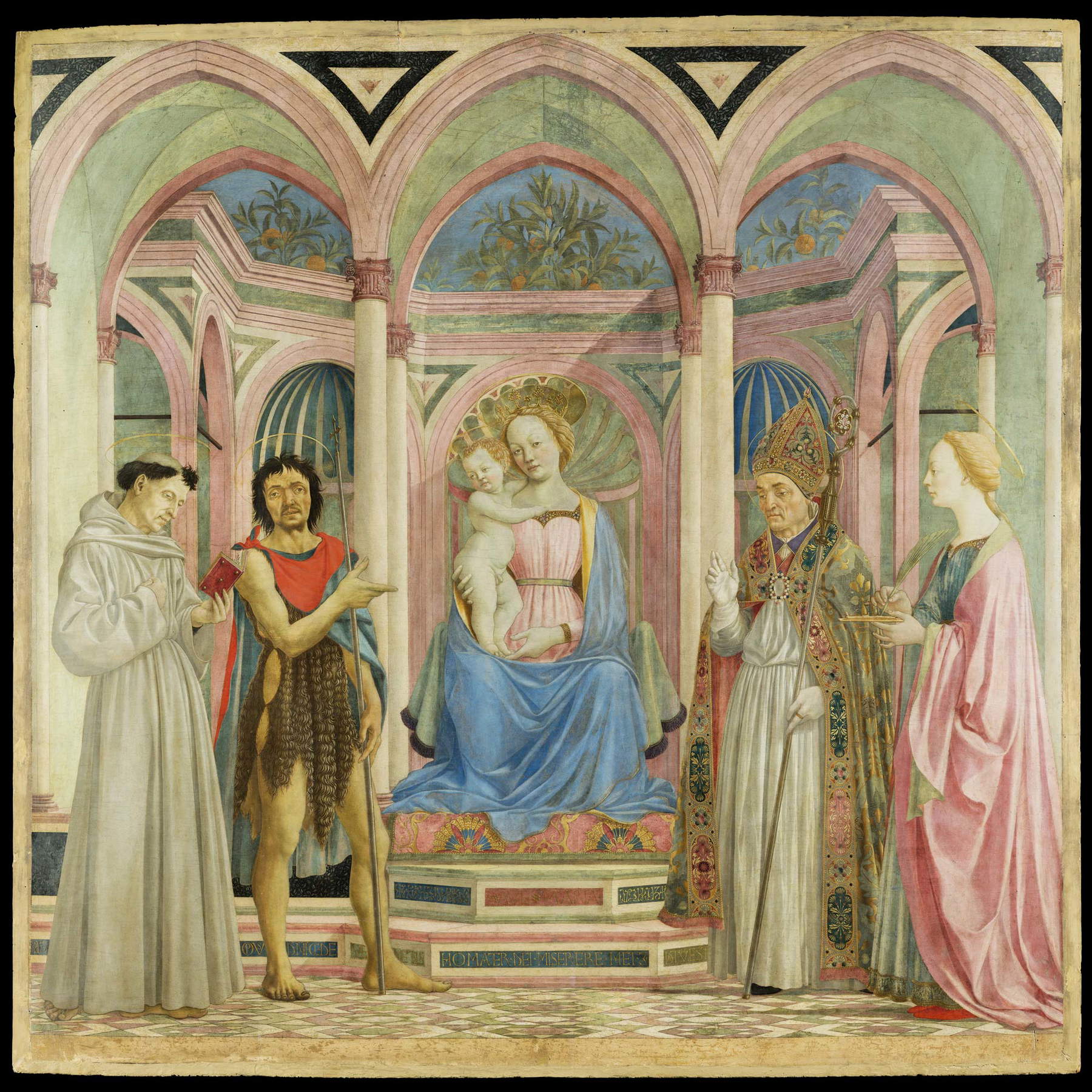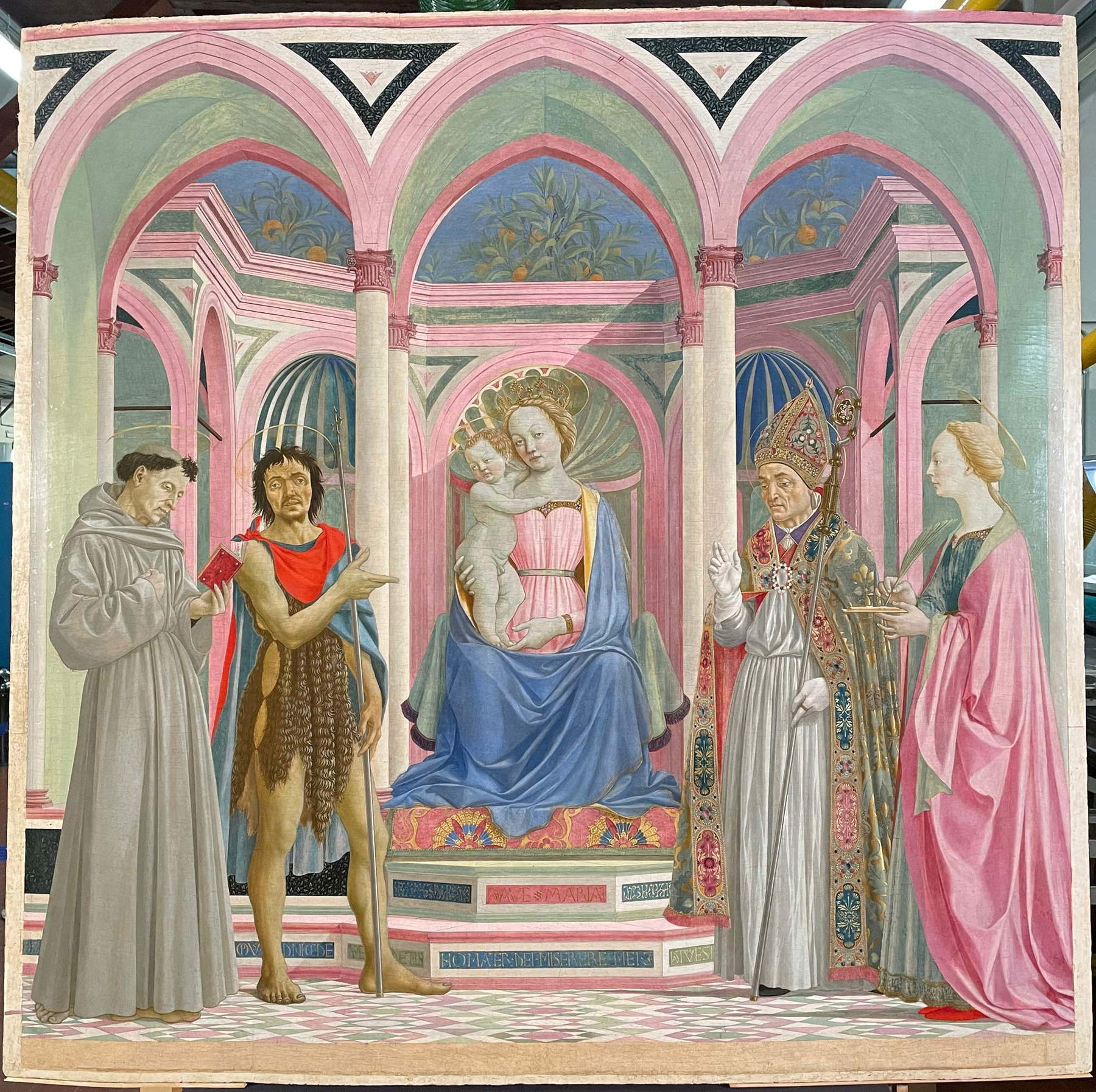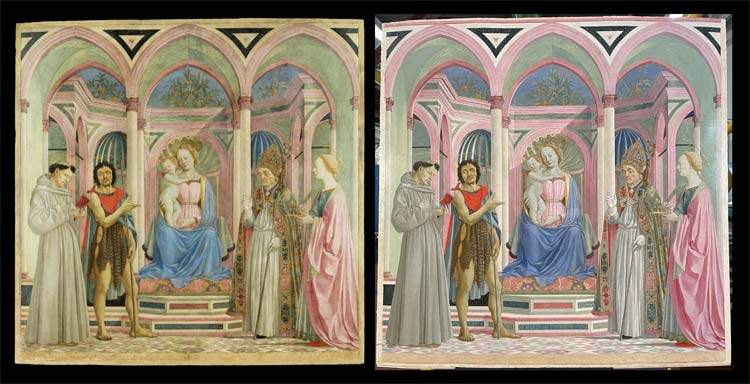Florence, finishes restoration of Domenico Veneziano's Magnoli Altarpiece
The restoration of one of the great masterpieces of the Renaissance ends: the Saint Lucia dei Magnoli Altarpiece by Domenico Veneziano, which has been at theOpificio delle Pietre Dure since 2019. With the surreal pink of the architecture, the luminous green of the walls and the blue of the Madonna’s mantle, the delicate chromaticism masterpiece of the great Renaissance master, dating from around 1445, returns to shine. The intervention was financed, through Art Bonus, by patron Giampaolo Cagnin, who wished in this way to pay tribute to the memory of his wife Anne Marie Bauer, a restorer engaged in the rescue of works of art after the flood that struck Florence in 1966. The delicate intervention, which began, as mentioned, in 2019 with an extensive diagnostic campaign, was presented to the press today, Dec. 12 . It will also be possible for the public to preview the work on Dec. 21, during the 10 a.m. to 1 p.m. and 2 p.m. to 4 p.m. time slots at the Opificio delle Pietre Dure Laboratory at the Fortezza da Basso (free access, reservations required at https://opd-effettorestauro.eventbrite.it). It is scheduled to return to the Uffizi Gallery, in the Pittura del Quattrocento rooms on the second floor, early next year.
Among the most important works of the early Italian Renaissance, as well as the only panel signed by the Venetian (who proudly affixes the inscription “OPVS DOMINICI DE VENETIIS” on the lower edge), the Magnoli Altarpiece was commissioned for the high altar of the church of Santa Lucia dei Magnoli on Via de’ Bardi by the Florentine Capponi family. The figures are arranged within a portico made with accurate perspective rendering and characterized by bright colors: white, green, blue and pink that give the scene a magical and supernatural dimension. Inside the portico, the Madonna and Child is flanked by Saints Francis, John the Baptist, Zanobi and Lucia. The saint holds a plate on which her own eyes are presented, a symbol of the martyrdom to which she was subjected. Beyond the architectural score, in the background, can be seen the crowns of three orange trees, whose presence combines symbolic meaning-spiritual fecundity-with a reference to the importation of this particular tree species, attested in those years by documents of the Medici family.
The Magnoli Altarpiece of Santa Lucia dei Magnoli became part of the Uffizi Galleries’ collection in 1862, already deprived of the predella composed of five compartments depicting theAnnunciation; Saint Francis Receiving the Stigmata; Saint John the Baptist in the Desert; the Miracle of Saint Zanobi; and the Martyrdom of Saint Lucia (now divided among the National Gallery of Art in Washington, D.C., the Fitzwilliam Museum in Cambridge and the Staatliche Museen in Berlin).
An earlier drastic cleaning operation, dating back to its entry into the museum, with subsequent patination with glue, haddepleted the paint film, causing the colors tolose their brilliance and giving it a dull, arid appearance, such that it was almost assimilated to a wall painting and the salient characteristic of luminosity of the whole was no longer perceived. One commentator at the time had called the work “a Chinese screen,” precisely to stigmatize the loss of the brilliance and saturation of the colors. Restoration has finally restored the painting to its colors.

 The Magnoli Altarpiece
The Magnoli Altarpiece“This was a job of great difficulty, made possible thanks to the generosity of a patron like Giampaolo Cagnin, who understood the delicacy of the undertaking, and to the very high professionalism of the Opificio delle Pietre Dure and its restorers,” comments Eike Schmidt, director of the Uffizi. “The expertise and scientific acumen required by this restoration have yielded unhoped-for results, which now also repay the patience of visitors who for three years, due to the interruptions caused by the lockdown, were unable to admire the painting in the Uffizi rooms. Its appearance now makes one forget the condition it was in before and allows us to better understand Domenico Veneziano’s great impact on 15th-century Italian painting.”
“When I saw the panel again in the Laboratories of the Fortezza, I said to Oriana Sartiani, ’it’s as if I’m seeing it for the first time,’” said Emanuela Daffra, superintendent of the Opificio delle Pietre Dure. “Yet it is a painting I know, have studied and love. However, the work at once meticulous and discreet, which has been able to hold in balance a painting that has suffered, recovering limpidities without pressing the pedal of cleaning or without hiding unveiling, gives us back the scanning of planes, the unfolding of profiles, the fantastic richness of details (I invite everyone to observe the cope of San Zanobi) with an unprecedented sharpness. I am truly grateful to the generosity of Giampaolo Cagnin, who has given us all an authentic gift. And on the day of the winter solstice, when darkness falls first, I invite everyone to come by the Fortress, to enjoy this immutable light for a moment.”
“The great fascination that this work exerted on its contemporaries comes back alive and palpable today thanks to the recovery of its original values of light and color,” emphasizes Cecilia Frosinini, representative of the Uffizi Scientific Committee. “The mixture between the abstract colors of the architecture, of Gothic origin, and the clarity of the geometric vision, all Florentine, was certainly one of the most fascinating aspects of the painting. If we imagine it inside the small and dark church of Santa Lucia dei Magnoli, we can understand how entering and seeing it on the high altar was equivalent to opening a window to the divine world, to the message of light of which the saint herself, in her name, was the bearer.”
“Giampaolo Cagnin’s participation in the restoration,” points out Sandra Rossi, director of the painting restoration sector of the Opificio delle Pietre Dure, “has not only the very important value of the liberal disbursement with which a modern patron decides to contribute to the preservation of the artistic heritage. In this case it also underscores a historical connection, through his personal story, with the world of restoration and, specifically, with the Opificio delle Pietre Dure. It was in fact within our laboratory that his wife, in the aftermath of the 1966 flood, came to lend her work in aid of the works of art damaged by that dramatic event. A solidarity and collaboration that today Cagnin wanted to reintroduce in memory of his spouse.”
 |
| Florence, finishes restoration of Domenico Veneziano's Magnoli Altarpiece |
Warning: the translation into English of the original Italian article was created using automatic tools. We undertake to review all articles, but we do not guarantee the total absence of inaccuracies in the translation due to the program. You can find the original by clicking on the ITA button. If you find any mistake,please contact us.



























